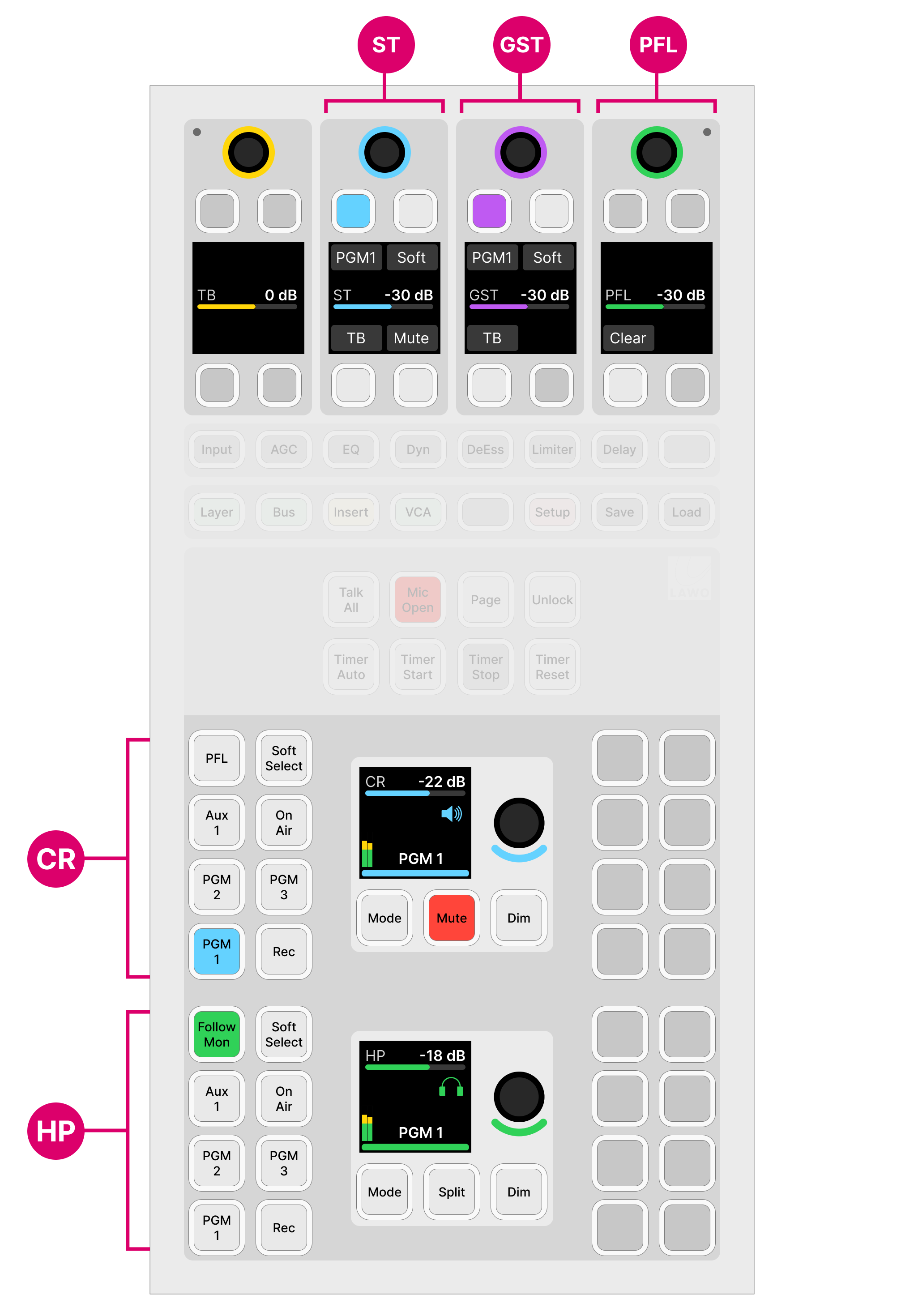diamond - Monitoring
diamond supports a number of audio elements that can be used to configure monitor source selection and master control. The number of monitor outputs, and their operation, is determined by the configuration. Usually, there are two main monitor outputs controlled from the lower part of the Central or Combo module. If additional monitor outputs are required, then these can be configured onto the upper Central Rotary Controls, or from additional Central/Combo modules running in monitor mode.
The rest of this topic describes the monitoring defined in the standard configuration. The operation may vary if the configuration is customized.
Controls Overview
The standard configuration provides five stereo monitor outputs:
- CR - for the control room speakers.
- HP - for the host headphones.
- ST - for the studio speakers.
- GST - for the guest headphones.
- PFL - for a PFL speaker.
Each output is controlled from the surface as follows.
Central Module |
Combo Module |
The controls are color-coded for easy identification.
- In the lower area: cyan = CR (Control Room); green = HP (Headphones).
- In the upper area: cyan = ST (Studio); purple = GST (Guest); green = PFL.
The Central and Combo modules offer identical functionality apart from the following. On a Combo module, the Studio (ST) controls are not supported, there are fewer monitor source selection keys for the Control Room (CR) output, and there are no dedicated Dim keys for the Control Room (CR) or Headphone (HP) outputs.
The control room (CR) and headphone (HP) controls are always present. The main points of operation are as follows.
- The large rotary controls adjust the monitor level/balance; turn for level; press down and turn for balance.
- The surrounding MF keys provide monitor source selection and other options.
The studio, guest and PFL controls become available when all of the Function Keys are off. In this instance:
- Each rotary control adjusts a single parameter: turn to adjust the output level.
- The soft keys provide monitor source selection, talkback and other options.
Most of the monitoring functions are operated from the surface. In some cases, pressing a key on the surface opens an overlay box on the GUI. The GUI also provides metering for the CR and HP outputs (via the master slots on the 'Channel Strip' page).
By default, the PFL output is switched automatically to the headphones (HP) whenever a PFL is active. The previous monitor source is re-instated once all active PFLs are cleared. If PFL is selected (as a Control Room monitor source), then PFL is switched to both outputs: HP and CR.
The Control Room and Studio output mute automatically when the Mic Open status is active (i.e. a Mic source fader is open).
Audio Connections
The default audio connections are described later in the Standard Configuration Specification. The connections can be edited using the ON-AIR Designer (under "Audio Output → <I/O> Out → Default Audio").
If you are running the diamond VX app, then you can use the 'Routing' page (on the GUI) to connect a monitor output to a destination:
- Select Routing (from the GUI page menu) to open the 'Routing' page.
- Under 'Sources', select the Monitor Outputs tab and choose a monitor section (e.g. Mon PFL) - the selection flashes in blue.
- Under 'Destinations', select an output category (e.g. Slot 1) and choose an output (e.g. Line Out 03) - the selection flashes in blue.
- Press Connect - the connection is made.
Control Room & Headphone Monitoring
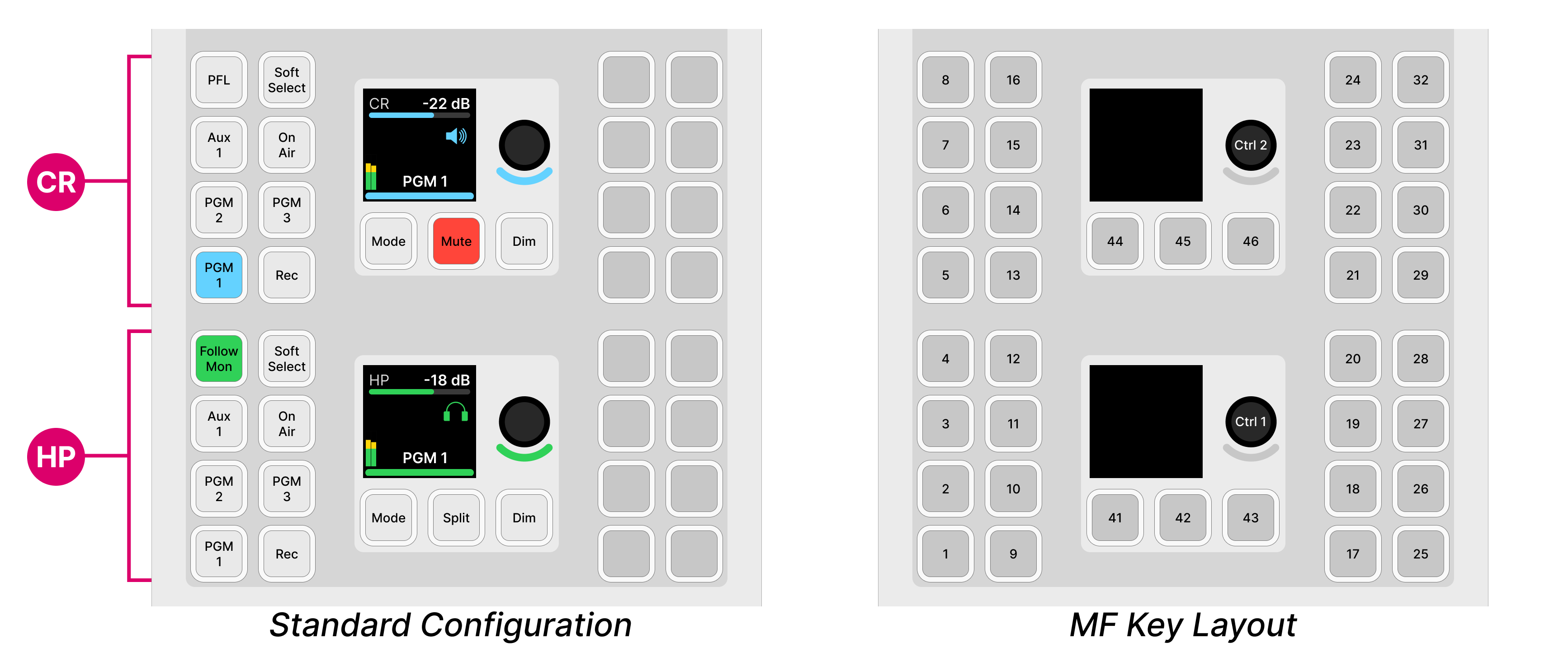
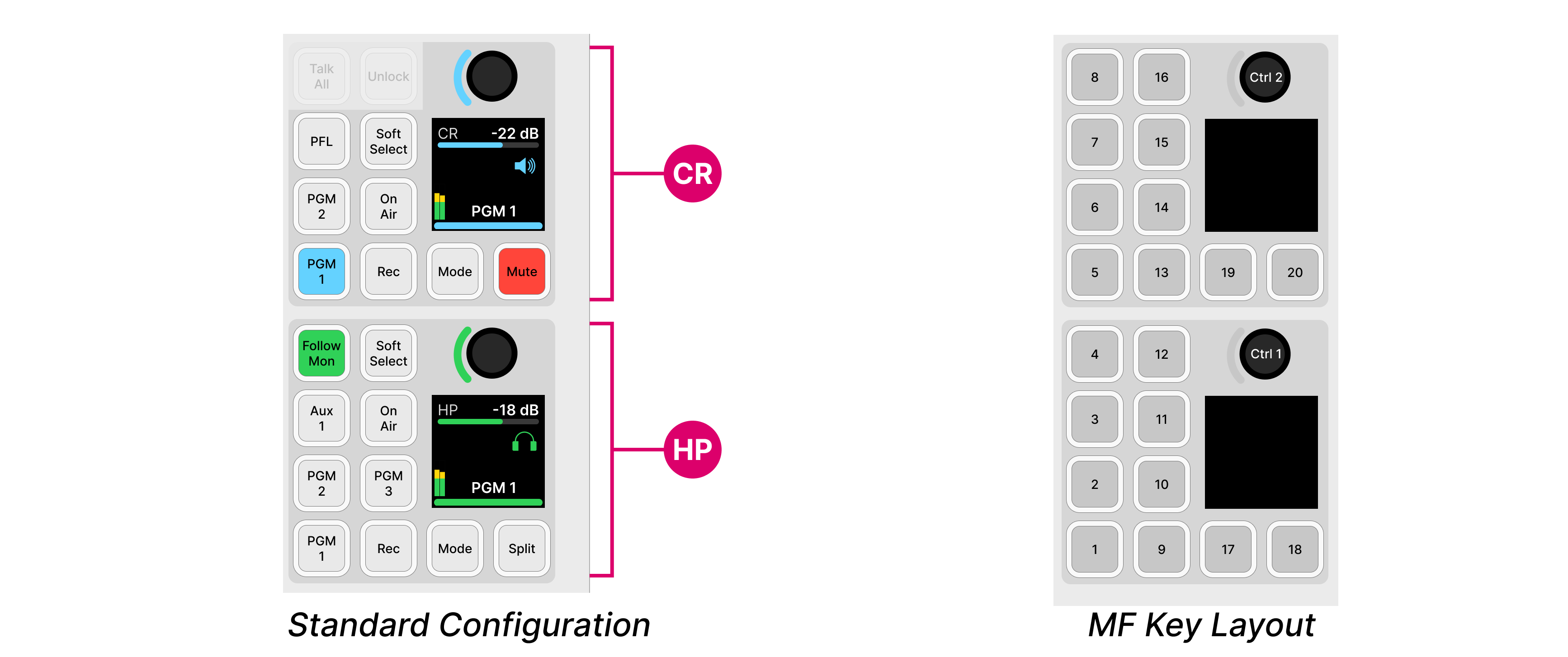
Monitor Level
For the Control Room and Headphone outputs, the rotary controls can adjust two parameters: turn to adjust the first (monitor level); push down and turn to adjust the second (monitor balance).
The display shows the control's function and current value, plus a media icon (to help with identification); output metering (pre-volume); and the current monitor source (e.g. PGM 1).
Monitor Source Selection
For the Control Room and Headphone outputs, there are 16 monitor sources available. The current selection lights in cyan (for CR) and green (for HP).
The first six sources can be selected directly from the surface: PGM 1, PGM 2, PGM 3, Rec, Aux 1 and On Air. On a Combo module, for the CR output, this drops to four sources: PGM 1, PGM 2, Rec and On Air. The Soft Select key provides access to the other sources via the GUI (as described later).
If you wish the headphones to follow the CR monitor source selection, then press Follow Mon (in the HP section).
By default, the PFL output is switched automatically to the headphones (HP) whenever a PFL is active. The previous monitor source is re-instated once all active PFLs are cleared.
If you wish to monitor PFL on the CR output, then press PFL (in the CR section). In this instance, PFL is switched to both outputs: HP and CR.
Other Functions
The remaining keys are for other functions.
For the CR output:
- Press Mode to change the monitoring mode (to mono the output, check the phase, etc). This key works in conjunction with the GUI (as described later).
- Press Mute to mute the Control Room output.
- On the Central module, press Dim to dim the Control Room output. The amount of dim applied is always 20dB. This function is not supported by a Combo module.
For the HP output:
- Press Mode to change the monitoring mode (with identical options as above). This key works in conjunction with the GUI (as described later).
- Press Split to listen to different signals in the left and right ears of the headphones: left = the selected monitor source (in mono); right = the PFL bus (in mono). You can use this to keep listening to a monitor source (e.g. PGM 1) while cueing up another source.
- On the Central module, press Dim to dim the headphone level. The amount of dim applied is always 20dB. This function is not supported by a Combo module.
The Control Room output mutes automatically when the Mic Open status is active (i.e. a Mic source fader is open). It can also be muted manually using the Mute CR button (above the HP monitor section).
Using the Soft Select key
The Soft Select key can be used to listen to a pre-selected monitor source. It works in conjunction with the GUI as follows.
1. Press and hold the Soft Select key to open the assignment window (on the GUI) - the key turns yellow to indicate that "assign mode" is active.
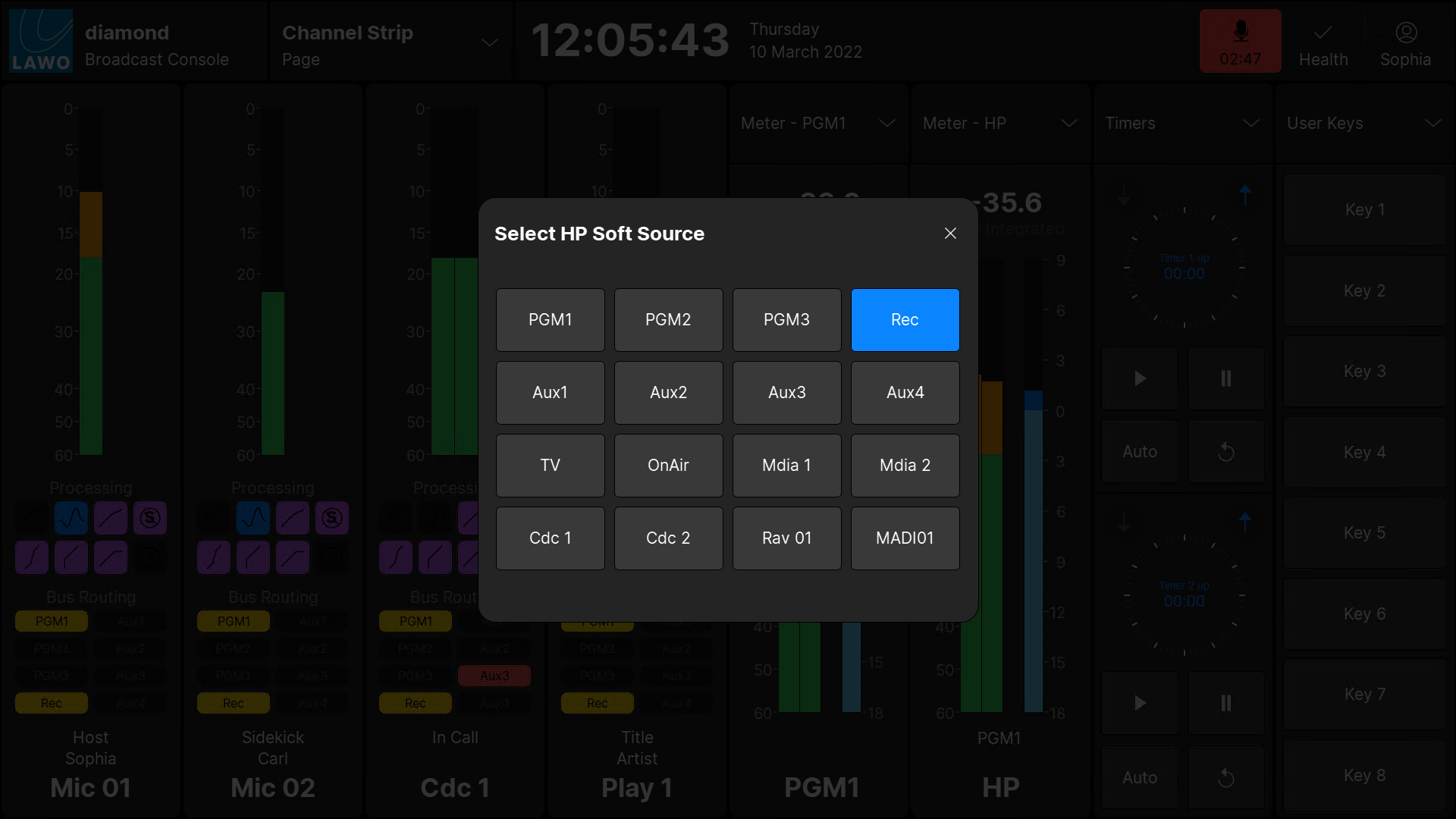
2. Choose an option using the on-screen buttons and then touch X to close the window.
3. Press the Soft Select key quickly to monitor the assigned source - the key turns green to indicate that the monitor source is selected.
The pre-selection is stored in the system's warm start data. This means that the Soft Key monitor source is re-instated after a restart, unless you perform a cold start.
The 16 monitor sources are defined by the configuration. See Standard Configuration Specification for details.
Using the Mode key
The Mode key can be used to mono the monitor output, check the phase, etc. It works in conjunction with the GUI as follows.
1. Press the Mode key to open the mode options (on the GUI).
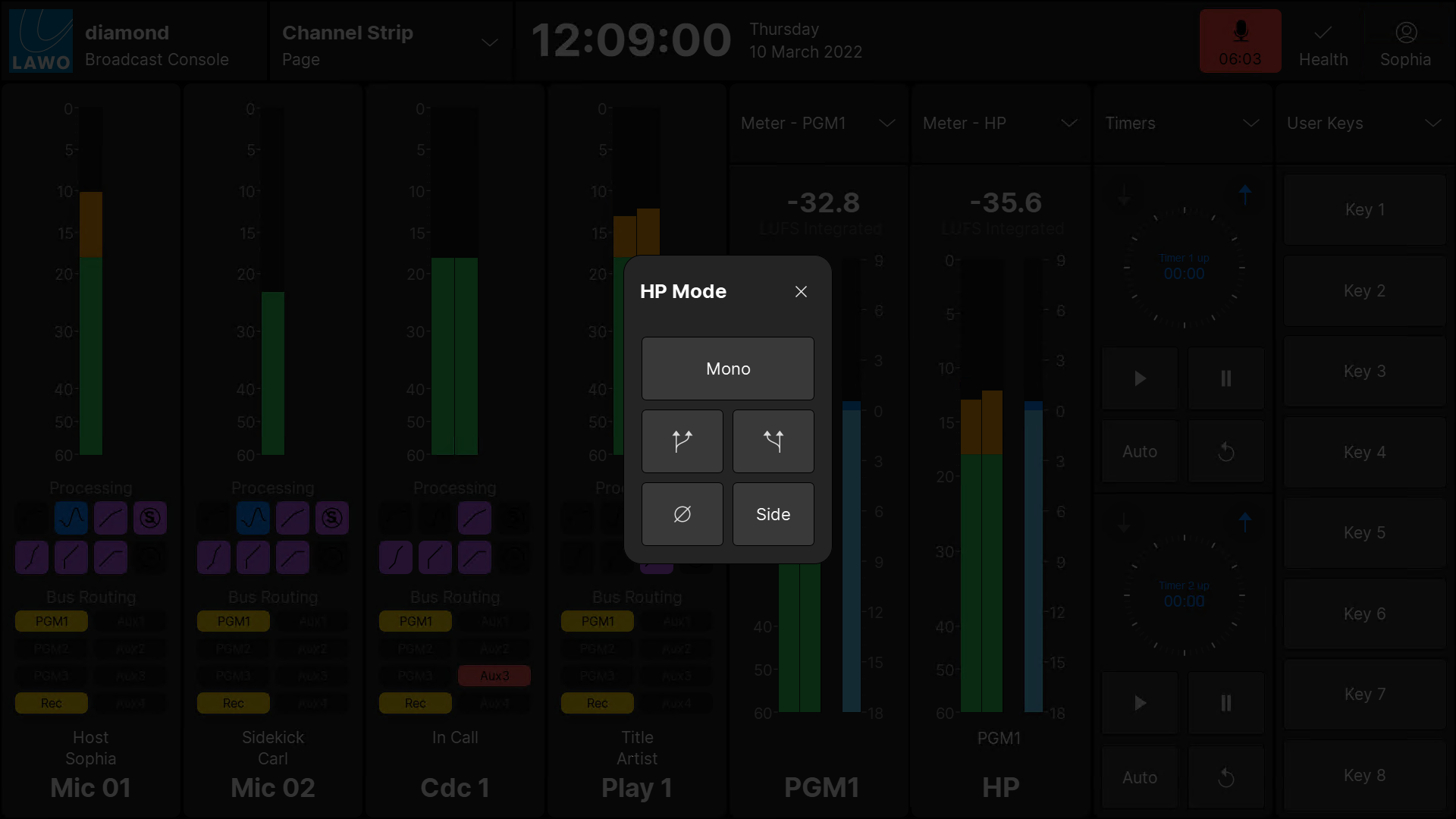
2. Choose an option using the on-screen buttons and then touch X to close the window.
- Mono - the left and right inputs are summed with a -3dB gain offset.
- L→B - the left input is routed to both sides of the matrix.
- R→B - the right input is routed to both sides of the matrix.
- Phase - reverses the phase of the left input.
- Side - the left input and right inputs are reversed (left input to right side of matrix, and right input to left side of matrix).
The current selections are stored in the system's warm start data. This means that the HP Mode is reinstated after a restart, unless you perform a cold start.
Studio & Guest Monitoring


For the Studio and Guest outputs, the rotary control adjusts a single parameter: monitor level. The display shows the control's function and current value. The current monitor source is highlighted (e.g. PGM 1).
There are two monitor source select keys: either PGM 1 or Soft. The Soft select key works in the same way as for the CR and HP output: press and hold to pre-select a monitor source (from the GUI); press quickly to monitor the assigned source.
The other keys operate as follows:
- Press TB to talk to the monitor output. The selected monitor source is dimmed by 20dB while talkback is active.
- Press Mute to mute the Studio output. The output mutes automatically when the Mic Open status is active (i.e. a Mic source fader is open).
PFL Monitoring
If PFL is selected (as a Contol Room monitor source), then PFL is switched to both outputs: HP and CR.
The Mon PFL output can be connected to a separate PFL speaker, either by editing the default audio connections (using ON-AIR Designer) or by making a connection from the 'Routing' page (on the GUI).
You can use the PFL master controls (on the Central or Combo module) to adjust the master PFL level or Clear all active PFLs.
